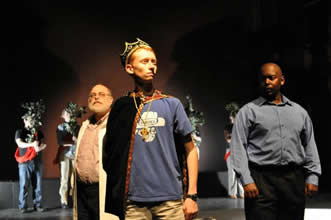Considering the inviting sunny afternoon as well as the conflict between the Triangle’s two shades of blue in UNC’s Dean Dome, there was a pretty decent house on hand at 3:00 p.m. Sunday, March 9, in Durham’s Carolina Theatre for an all-program-music concert by the Chamber Orchestra of the Triangle under the expressive hands of Music Director Lorenzo Muti. Despite the very generous free admission for students, far too few youngsters were on hand to take advantage of the opportunity. Most of the audience came from the orchestra’s regular loyal following, which includes a large contingent of residents of retirement communities.
The centerpiece of the program was the world premiere of Robert Ward’s Dialogues, a Triple Concerto for Violin, Cello, Piano and Orchestra . At a lecture in the Forest at Duke Auditorium March 6, Dr. Ward gave the background of two earlier works, Dialogue I and Dialogue and Time , that were reworked as elements of the new score. The first is a double concerto for violin and cello, commissioned and played by the Chattanooga Symphony in 1982 and arranged for piano trio in 1984. Then, in 1987, for a “Concert for Peace” organized by N.C. Symphony members, Ward composed Dialogue and Time , a double concerto premiered by violinist Jaime Laredo and cellist Sharon Robinson. Using Dialogue I as the basis for the first movement of the new Triple Concerto, the composer added a piano part, created a short linking Interlude, and modified the 1987 work to become Dialogue II , “On the Joy of Living,” which serves as the new concerto’s ending. He describes Dialogue I as depicting a calm, euphoric time before the tensions of the Cold War. The brief interlude leads to Dialogue II , which reflects the fear of nuclear war in a more overtly concerto-like scoring. He uses the form of a quodlibet to combine melodies from the national anthems of China, Israel, Japan, Syria, Russia and the USA. After the climax, the mood returns to the more peaceful atmosphere of the first Dialogue with a hymn-like tune.
The Triple Concerto was composed for the Arman Piano Trio, which has presented many fine programs of French music in the region. In a departure from the norm, the lidless piano of Deniz Gelenbe was placed with the keyboard facing the right side of the stage. Cellist Dorel Fodoreanu’s raised seating was about even with the conductor (whose alert eye and quick action helped the cellist avoid slipping off the back edge), and violinist Constantin Bogdanas stood to the cellist’s right. The Concerto, full of melodies, is a tonal work. It opens with a sweet violin solo taken up in turn by the rich cello and soon joined by the full string section. Woodwinds enter, and there is a prominent line for the oboe, on this occasion played by Bo Newsome. Perhaps reflecting the work’s origins as a double string concerto, the piano has long periods of counting rests and gently enters only after the movement is well underway. The scoring of a passage for the assertive piano and a pair of horns proved especially memorable. Though I don’t suffer from absolute pitch, I thought there was an intonation disparity between the soloists and the string choir near or in the brief interlude. The last movement has a much more even distribution of the three solo parts. The finale’s complex orchestration was well executed, and the premiere performance received several enthusiastic curtain calls.
The concert opened with a short and pleasant work, Summer Day Suite , by Serge Prokofiev. An orchestration of seven pieces from his Children’s Suite, for piano, it shows off the quality of each section of the orchestra, especially the woodwinds. The “Repentance” movement, with deep, rich cellos and violas, a mournful bassoon (played by Christopher Ulffers) and plaintive oboe (Newsome), is the most moving. There were some intonation problems in some of the short movements.
Muti and the COT have presented more unusual scores by Ottorino Respighi than anyone in the immediate three states that I have heard about. Muti confessed to loving the composer’s melodic works and finding his smaller pieces often more sophisticated than the larger tone poems. Respighi’s Trittico Botticelliano presents tone-poem depictions of three of Botticelli’s most famous paintings. Cascades from Randall Love’s piano and a stirring and rising figure in the orchestra conveyed “La Primavera,” the birth of Spring and its accompanying burst of new growth, with trills in the winds and strings. Horns hints at the Hunt. An old hymn, “O Come, O Come, Emmanuel,” with solemn and rich string scoring, serves as a basis for The Adoration of the Magi. In the middle, the piano, triangle and harp join to depict the arrival of the Three Kings. The image of the sea never went unheard throughout “La nascità di Venere,” with its suggestive undulations and surges surrounding the goddess in her seashell. It was nice to hear a rare performance of Respighi’s first Suite of Antiche Danze ed Arie per Liuti , for full chamber orchestra, instead of the Third Suite, for strings alone, which has been played often locally. The composer took these Renaissance lute pieces and orchestrated them with a 20th-century aesthetic. All sections of the orchestra played well. Elaine Funaro’s unamplified harpsichord could be easily heard from the first loge, the Carolina Theatre’s sweet spot. Fine solos were given by Concertmistress Claudia Warburg, cellist Virginia Hudson, oboist Newsome, bassoonist Ulffers, harpist Emily Laurance, and hornists Mary Burroughs and Pam Halverson, and highest praise goes to the subtle and beautifully balanced trumpet playing of Dave McChesney. We have seldom heard such sensitive playing on that instrument in any ensemble.











